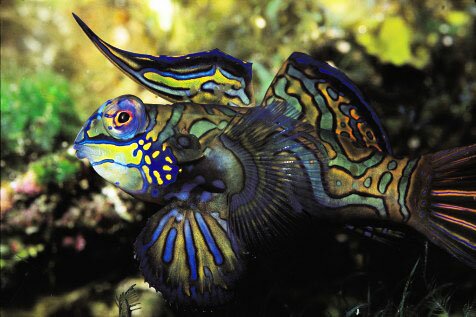Green Mandarin
From Microcosm Aquarium Explorer

This species does best in well-established reef tanks without aggressive feeding competition. Scott W. Michael
Overview
This is a great reef aquarium species. It is not a threat to invertebrates and is highly disease-resistant. It has even been known to spawn in reef aquariums.
It, does, however, have a poor survival record in fish-only community tanks, where it often cannot compete for food and there is little in the way natural grazing on amphipods and other small prey items that inhabit live rock and live sand.
Family: Callionymidae
Other common name(s):
- Striped Mandarin
Native range:
Habitat: The Green Mandarinfish is usually found in small groups in shallow protected lagoons and inshore reefs on silty bottoms with coral and rubble.
Maximum length: 8 cm (3 in)
Minimum aquarium size: 76 L (20 gal)
Water: Marine 24 °C (75 °F) - 28 °C (82 °F)
Feeding
It will eat black worms, enriched live brine shrimp, and mysid shrimp. Target feeding is often needed to ensure it gets enough to eat. Feed three times per day in a tank without live rock.
Aquarium Compatibility
The Green Mandarin will ignore other fish species, but males will attack and bite male conspecifics. (Males are easily recognized by the presence of long dorsal spines.)
Special Care
Keep in a tank with live rock, possibly with an attached refugium. It will do better in a tank that contain lots of filamentous algae, which usually harbors rich crustacean fauna.
Breeding/Propagation
It is possible to breed this species in small-scale propagation tanks. See: Breeding the Green Mandarin by Matthew L. Wittenrich.
Notes
Choose your fish carefully; bringing a skinny Green Mandarin back to good health is usually an uphill battle. It always does best in well-established reef tanks without aggressive feeding competition.
Scientists worry that the overcollection of large males in the Genus Synchiropus is harming the quality of wild stocks.
See: Mandarin Harvest Realities, also by Matt Wittenrich.








